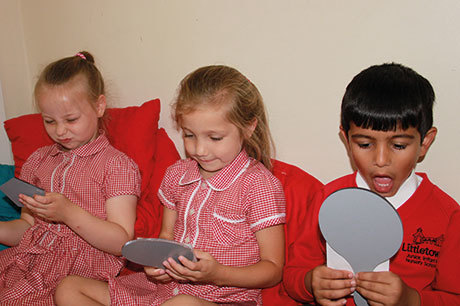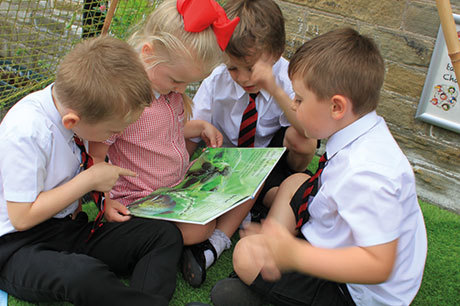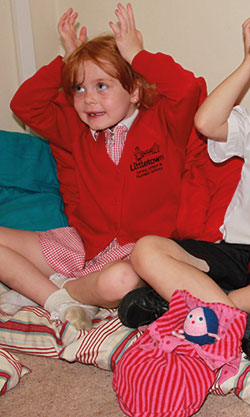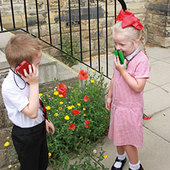
Download the PDF of this article
At Littletown Junior, Infant and Nursery School in West Yorkshire, we have sought to address the long-standing problem of our children’s poor communication and language skills, in particular their vocabulary. As a school, we knew about the link between a child’s speech and language skills and their life chances and that to tackle the vocabulary problem effectively, we had to start with our youngest children.
Many of our nursery children still refer to themselves as ‘me’ (for example, ‘Me do that’) and their sentences consist of only three or four words. Conversations with them are limited, as is their vocabulary, with children often saying ‘there’ or ‘that thing’ instead of naming the place or object.
Almost 60 per cent of the children on our SEN register have speech, language and communication needs (SLCN), and this year 50 per cent of all our referrals for speech and language therapy were for children in the early years.
This problem of poor vocabulary persists, with children finding the vocabulary in the reading papers the hardest part of the SATs tests in Years 2 and 6. In one test a few years ago, some of our Year 6 children did not understand words such as ‘monument’ and ‘dawn’.
Providing inspiration for change was Julie Fisher’s book Interacting or Interfering? Improving interactions in the early years, which reminded me of the importance of effective early interactions and the links between language and life chances (see box).
INITIAL ASSESSMENT
As early identification is so important, we wanted to ensure that we were managing to identify all the children with SLCN. We had never used a standardised measure for children’s language skills, so sought the advice of a speech and language therapist. After discussion, we decided to use the Renfrew Action Picture Test and Renfrew Word Finding Test, to provide us with a standardised score and an age score for speech and language. The tests, which looked at vocabulary, information given and grammar, were completed in September 2017, scored by our language therapist and confirmed what we expected:
In the Renfrew Word Finding Test, 55 per cent of the nursery and 16 per cent of Reception children did not score – their language was deemed to be below that of a child aged three years and three months. A further 14 per cent in nursery and 52 per cent in Reception were below ‘age appropriate’.
These results also produced a standard deviation (SD) for each child – 0SD is where the majority will fall on the bell curve, with some children scoring positively (for example, 1SD or 2SD) or negatively (for example, -1SD or -2SD). Some children in nursery scored below -4SD.
On the Renfrew Action Picture Test, 60 per cent of Reception children were below 0SD for information and 52 per cent for grammar; 73 per cent of nursery children were below 0SD for information and 50 per cent for grammar.
Seeing the figures written down was concerning and we immediately put a plan in place, using the SD scores to decide which children required intervention. We also used the data to see if some children needed referring to speech and language therapy.
AIMS
Through our intervention, we aimed to:
- raise the speech and language levels of all the children in the early years
- have as many children as possible with a vocabulary at or above what was expected for their age
- have the majority of children achieving the standardised score of 0 or above for information and grammar.
While all aspects of language needed improving, vocabulary was a key focus, and following on from that we also modelled narrative structures.
STRATEGIES
We wanted to ensure that all the children in the early years were immersed in a language-rich environment – that phrase is often used, but we wanted to ensure that this was oral, not written.
Specific words As staff, we agreed to replace imprecise phrases such as ‘put it over there’ with specific instructions and descriptions as a means of extending children’s vocabulary. So, for example, instead of ‘Put it away’, we would say, ‘Put it in the red box on the bottom shelf’.
Nursery Narrative We had successfully used Black Sheep Press’s Nursery Narrativewith children who were having speech and language therapy. However, we decided to do it with all Reception children who scored 0SD or below.
Time to Talk In nursery, we decided to use another book called Time to Talk by Alison Schroeder. We split all the children into five groups, based on the Renfrew ability scores, and used the book twice a week with the lowest-scoring group and once a week with the others. The sessions were held in a small quiet room.
Nursery rhymes We focused more on nursery rhymes. According to Mem Fox, in studies of literacy and child development, ‘if children know eight nursery rhymes by heart by the time they are four years old, they are usually amongst the best readers by the time they are eight’ (Reading Magic, 2001).
We had always sung them in nursery and had a focused music session in Reception, but on closer observation we found that many children could join in only part of a rhyme and few could sing it word for word. We introduced a rhyme of the week with a display with the words and characters or objects on it. Reception and nursery sang the song and previous ones over the week. We suddenly had children starting to ask for specific rhymes and joining in all the words and actions.
Stories We started to spend more time exploring the meaning of words in stories. We spent time reading and re-reading a wide variety of stories, especially ones that children could learn and join in with the retelling. We dedicated some of the time to explaining and defining some of the words. After reading The Lighthouse Keeper’s Lunch by Ronda and David Armitage, it was lovely watching a little boy with low levels of language practise saying the word ‘concoction’ and feeling how it sounded and felt on his tongue.
Den We wanted to ensure that talking was promoted inside and out, so we created a cosy little den and called it the Chatter Hut. The children used it for all sorts of activities, but enjoyed using the space to share books or sing songs together. Sometimes adults would sit in the den and children would join them for conversations. It worked out to be a lovely space that promoted chatter naturally.

Resources We used toys that promoted communication, such as mobile phones and Hear Myself Sound Plastic Telephones, both of which the children really enjoy using for role play, to play games with and to talk to each other.
It was difficult to find the time to implement the strategies and strike a balance between these and other elements of the curriculum. Nursery rhymes, however, were slotted in everywhere possible – while lining up, walking to the hall, at the end of a story.
WORKING WITH PARENTS
We invited parents to a Chatter Event, where they joined their children in exploring activities to promote conversation and communication. We shared with them some of the facts about communication and life chances, as well as how long it takes for children to learn a new word.
We then showed them some I CAN booklets offering ideas on how to support communication at home, such as the Talk Togetherleaflet. These included activities and games that could easily be repeated at home such as puppet theatres, shadow puppets, barrier games, Kim’s Game and blindfolded obstacle courses.
We also held a Grab a Grown Up day in partnership with our patron of reading, author and poet Conrad Burdekin. We encouraged parents to send in pictures of themselves reading with their children and invited them to attend workshops with Conrad and work with their child. The nursery children had a smaller interactive session.
Both sessions involved Conrad modelling how you could make a story up about anything, tell a story without a book and have fun with words and language. Parents then worked with their child to make up their own stories. It was a wonderful day, parents’ feedback was exceptionally positive and it was very well attended, with all Pupil Premium parents attending.
Conrad’s message was that: ‘Words are not only vital for communication, they can also be the basis for lots of fun between parents and their children. I’ve been playing with words for many years, and children never tire of the humour and adventure that can be created when using them.
‘A good storybook offers the perfect opportunity for parents and children to play with language. Big words, small words, loud words, quiet words, rhyming words, made-up words – they’re all available from stories and they’re all ways for grown-ups to help their children improve their speech and language skills. Most of all, though, words are fun.’
OUTCOMES
At the end of June, we repeated the tests, which were again done in a quiet space with a familiar adult, who was confident to administer the test, and marked by our speech and language therapist. Here are some of our findings:
In the Renfrew Word Finding Test, 100 per cent of nursery children scored. Seventy-three per cent of nursery and 76 per cent of Reception children scored above their age.
Of the children who were below 0SD in nursery, three had been referred to a speech and language therapist, two have English as an additional language and one child qualifies for Pupil Premium. Of the children who were below 0SD in Reception, one has an Education, Health and Care Plan (EHCP), two are on My Support Plans (all three for SLCN and other needs), two are summer-born and one has English as an additional language.
84 per cent of Reception children were 1SD or higher in the grammar Renfrew Action Picture Test, compared with 32 per cent on entry, and 64 per cent were 1SD or higher for information, compared with 20 per cent on entry. In nursery, twice as many children were 1SD or above for information and 55 per cent were 1SD or above for grammar.
We were thrilled with the results, which represented a huge amount of progress. They have also highlighted children we know need more specialist help, so that we can be sure of early identification and support.
We are going to continue all the strategies and have added Key Stage 1 Nursery Narrative from Black Sheep Press into Year 1 as well.
Head teacher Fiona Ward says, ‘All teachers are highly aware of the need to increase life experiences for all children, but this project has taken this idea a step further. By using an action research approach, the staff in early years have grasped an impact-driven philosophy and are making a difference to the long-term life chances of our youngest pupils.
‘The precise use of adult language to gain repetition and acquisition of everyday and unusual vocabulary will, I believe, result in higher-order reading skills in KS2. We will track and watch with interest this cohort’s progress, and each further teacher will continue this vocabulary-focused philosophy.’
C & L AND A CHILD’S LIFE CHANCES: THE LINK
Children’s vocabulary at age five is a key predictor of how well they will perform at the end of Key Stage 1 and 2, a ‘very strong predictor’ of school leaving grades and ‘the best predictor’ of whether children who experienced social deprivation in childhood were able to ‘buck the trend’ and escape poverty (Feinstein and Duckworth 2006, Blanden 2006, Fisher 2016).
‘The long-term impact of under-identification and lack of support for speech, language and communication needs is significant… Two thirds of young offenders have speech, language and communication difficulties, but in only 5 per cent of cases were they identified before the offending began’ (The Communication Trust).
The updated Bercow report, Bercow: Ten Years On, says that ‘42 per cent of parents and carers said their child’s SLCN were noted too late’ and that ‘Strategic system-wide approaches to supporting SLCN are rare; very often SLCN does not feature in national or local policies… A new cross-government strategy for children should be developed, with speech, language and communication at its core.’
In July, Education Secretary Damian Hinds announced £30 million in funding to help address the problem – ‘28 per cent of children finish their Reception year still without the early communication and reading skills they need to thrive… My ambition is to cut that number in half over the next ten years.’
NURSERY WORLD SHOW
Vocabulary development will be the theme of two seminars at the Nursery World Show in London on 1 and 2 February.
Other themes include early maths, a Froebelian approach to behaviour, outdoors-only provision, physical development and self-regulation.
For full details of our seminar and masterclass programme and to book, visit: www.nurseryworldshow.com
SCHOOL PROFILE
Littletown Junior, Infant and Nursery School is a small, one-form entry school in Liversedge, West Yorkshire, and has:
- average percentage of children qualifying for free school meals (13 per cent)
- 13 per cent of children with English as an additional language (EAL)
- around 33 per cent of children with special educational needs (SEN), compared with the average of 14 per cent
- nearly 60 per cent of children on the SEN register with speech, language and communication needs (SLCN). Locke et al (2002) note that in areas of disadvantage, over 50 per cent of children have SLCN.
 MORE INFORMATION
MORE INFORMATION
Interacting or Interfering? Improving interactions in the early years by Julie Fisher (2016)
www.thecommunicationtrust.org.uk/media/540327/tct_talkingaboutageneration_report_online.pdf
Twitter: @MrsHLombard, @LittletownEYs, @LittletownSch









